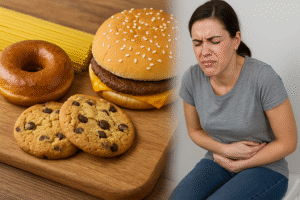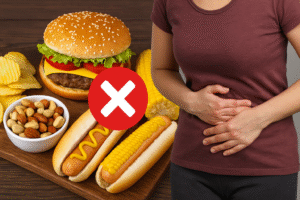Do you ever wonder why the stubborn belly fat refuses to disappear no matter how many crunches you do or how clean you try to eat?
The villain might lurk right in your kitchen. Some every day foods can cause inflammation in your body, which can make it difficult to slim down and your energy up. And the worst part? You may not even know they’re causing harm.
In this guide, we’re dissecting the worst inflammatory foods that make belly fat—and simple swaps to help cut them out (without losing any taste or pleasure).
Why Inflammation Is a Big Deal When It Comes to Belly Fat
Let’s start with the basics. Inflammation is not all bad — it’s how your body naturally responds to injury or infection. But when it becomes chronic, it can do more harm than good. One: Chronic inflammation is known to be associated with numerous health problems, including heart disease and diabetes (among—you guessed it—stubborn belly fat).
Your body views some foods as “threats,” and it’s this low-level inflammation that could be the culprit. Over time, that can influence how your body stores fat, particularly in the midsection.”
7 Belly Fat Causing Foods That You Should Avoid
White Bread and Refined Carbohydrates
Ever wonder how white bread, bagels and some cereals just taste so damn good? That’s often because they’re stuffed with refined carbs that your body turns into sugar quickly. What happens next? A high followed by an energy low.
Why it’s bad: These fast-digesting carbs can promote inflammation and lead to storing belly fat.
Instead try: Whole grain options such as oats, brown rice, or whole wheat bread.
Fried Foods
Nothing beats a plate of fries, but deep-frying will transform even innocent veggies into inflammation bombs. Fried foods are usually (you guessed it) fried in unhealthy oils that contain trans fats—the type that causes heart disease and, yep, even more belly fat.
Why it’s unhealthy: High in calories and bad fats which dismantle your gut and metabolism.
Instead, do this: Oven-roast or air-fry your favorites. Same crunch, less damage.
Sugar—Especially in Drinks
If you have a sweet tooth (guilty, Your Honor!), it’s easy to miscalculate just how much sugar you’re ingesting. But sweetened drinks like soda, sweet tea and even some fruit juices top the list.
Why it’s bad: Sugar will spike your insulin levels and facilitate fat storage around your belly.
Instead try: Flavored water (infused with fruit), herbal teas or plain old water with lemon.
Tip: Always check the label. That “power-packed” smoothie could contain 40+ grams of sugar!
Processed Meats
Deli meats, bacon, sausage—these flavorful protein favorites can make lunchtime more convenient, but with them comes an unhealthy dose of sodium and preservatives.
Why it’s bad: These ingredients cause inflammation in our bodies, and have been linked to increased risk of chronic disease.
Instead try: Go for lean, full meats like grilled chicken or a turkey breast.
Artificial Trans Fats
Thankfully, a lot of brands are in the process of phasing out trans fats, but you can still encounter them in processed snacks, frozen items, and margarine.
Why it’s bad: These fats boost bad cholesterol (LDL) levels and up inflammation in the body.
Instead, try: Read ingredient lists carefully and watch for “partially hydrogenated oils.”
Too Much Alcohol
It may not feel like you’re slugging much back with that nightly glass of wine — but it can add up quick, particularly if you’re pouring yourself more of a “restaurant size” than a “serving size.”
Why it’s bad: It turns out, drinking too much can lead to inflammation in your liver and disturb how your body stores fat.
Instead, try: Restricting consumption to a few drinks a week and drinking water in between.
High-Fructose Corn Syrup
All is not so good with this sneaky ingredient that turns up everywhere from salad dressings to breakfast bars. Unlike natural sugars, high-fructose corn syrup can be harder for the body to break down, especially in large quantities.
Why it’s not great: It can lead to more belly fat and insulin resistance in the long haul.
Do this instead: Pick whole foods and cook at home when possible; this way, you have more control over what is in the food you eat.
What Can You Eat Instead?
All right, you know what to cut back on — but what should you be downing instead? Concentrate on foods that help to fight inflammation and reduce belly fat.
Top Anti-Inflammatory Foods:
- Leafy greens (such as spinach or kale)
- Fatty fish (such as salmon and sardines)
- Whole grains (quinoa, brown rice, oats)
- Healthy fats (olive oil, nuts, condiments and avocado)
- Naturally bright fruits (berries, oranges, cherries)
Eating these foods can help you lose weight and feel better overall. It’s a win-win!
Takeaways: How Small Changes Can Make Big Differences
Loose this fat gain isn’t just about the calories — it’s the quality, too. If you’re still eating foods that promote inflammation, your body’s going to struggle to shed that belly fat no matter how hard you work out.
The good news? You don’t have to go on an extreme diet. Simply paying attention to what you are eating — and swapping out a few pro-inflammatory foods for more-inflammatory foods — can make a significant difference over time.
Consider it akin to straightening up your kitchen and your body. Less irritation, more energy, and sure, less belly fat.
What’s One Inflammatory Food You’re Willing to Give Up Today?
Start small. Pick one thing you’re going to cut back on this week — and then replace it with a better alternative. The little waistline hates it.
Bonus Tip: For a few days, keep a food diary. You may be surprised at what’s sometimes slipping into your diet!
Stay with Us and Stay Healthy
Need help? Subscribe to our newsletter for more advice on what to eat (and how to find balance during difficult times) to feel your best.
Remember: Your health is not about being perfect. It’s about progress. One smart choice at a time.








